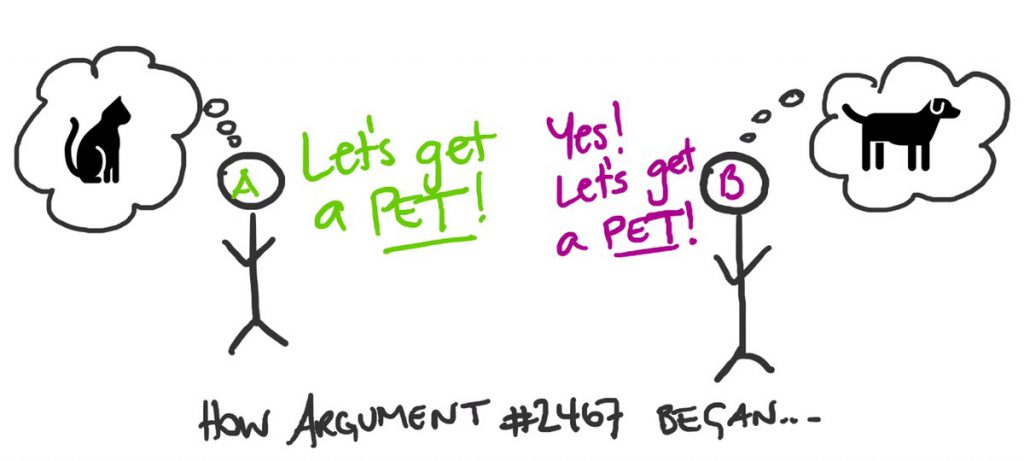
A few years ago, my husband Rob came to work one Monday, in his normal work mode – let’s get down to business. One of our employees had a very high preference for personal comments and feeling important. Rob walk passed her, said “Good morning” and then went about his business.
3 hours later, there was a timid little knock on his door. He looked up and the employee was standing at his door. He invited her in and asked her what she wanted. She looked at Rob and asked “What have I done wrong?”
Have you ever been in the situation where something you’ve said had a completely unanticipated response? What about that time when you thought you asked one of your team members to do XYZ but they did ABC? I’d hazard a guess that if you’re a business owner or manager it happens to you on a very regular basis!
When misunderstandings and misinterpretations do happen, what’s our usual reaction? The vast majority of us blame the other person. Why did you do that? What didn’t you understand about my instruction? Why are you wasting your time and mine? What’s wrong with you?
Many years ago, I was introduced to the principle “True communication is the response I get”. This principle says to me that in my communication with others, if I’m not getting the result that I want, then the starting point is looking at WHAT and HOW I communicated what I want.
If you’ve read our earlier blogs on communication, you’ll be familiar with the formula for communication theory.

Person A “encodes” their message from their own perspective, having very clear in their mind the message that they want to put across. Person B then “decodes” the message from their perspective.
Inevitably, if person A does not ensure that person B receives the message that they intended, then unsurprisingly, person B goes and does something different to what person A wanted! This is typically how most misunderstandings start.
With this in mind, it’s quite possible that your employee is not being deliberately hard to get along with, it’s just how they’ve interpreted what you’ve said to them!
Within a group of people there’s a wide variety of personalities. Every one of us are different and we each see things from a many different perspectives. Importantly, for each one of us, OUR PERSPECTIVE IS RIGHT TO US.
One of the tools that we use with our clients is DISC. It’s a great tool that does the following 3 things:
According to DISC, there are four distinct communication styles and each of us operate to varying degrees within them. Some of us are very direct, demanding and domineering in our communication to others, we think and speak very quickly. When someone asks us a question, we can generally come back with an answer very quickly. We don’t like lots of detail and in fact when we get a report, all we’ll generally read is the executive summary.
Some us in our communication like to make sure in every situation we are able to share our opinion about the subject being discussed. We like our ideas and intentions to be expressed and we don’t like to be legislated or muffled. We like to make sure that there is time for relationship building in all our communication (whereas the previous people don’t want to do that – they just want to get down to business and get it over and done with as quickly as possible).
Others of us want to make sure that all communication begins with personal comments and the ice is broken; we don’t want to rush headlong into business or the agenda. Unlike the first example given above, this group of people when asked a question need to think about their response before answering. Their communication is more deliberate and more considered. This communication preference is actually the vast majority of people.
The fourth group of people are the ones that MUST have all the details. Communication with them MUST be organised. They will not give a quick decision, because they won’t make a decision unless they have all the facts. These people must be given the opportunity to be prepared, they don’t like being put on the spot. With this group, you must also always do what you say you are going to do – flippancy and exaggerated statements are abhorrent to this group.
No doubt you can see that these 4 different communication preferences automatically create tension between individuals.
What this tools teaches us is if I have the preference to be short, sweet and straight to the point, when I’m communicating to the person who wants all the details, I’ve got to forget what I want and think about what they want and give it to them.
Conversely if I’m the type of person who wants all the detail, when I’m talking to the person who wants no detail, I’ve got to forget my preference and communicate to them in terms of their preference.
Obviously, this takes some very conscious choices, constant awareness about who you’re speaking with and often make us feel very uncomfortable.
So, back to Rob and our employee.
Rob sits quite squarely in the first group of people I described. His communication style is direct, and even domineering at times. When he walked past our employee and only said, ‘Good morning.’ without asking her about her weekend or her kids, he had forgotten her preference for communication is primarily for connection. So when she knocked on her door 3 HOURS LATER asking what she’d done wrong, he know immediately what he had not done. He had said ‘Good Morning’ in a communication style that suited HIM, not her. The result of this momentary lapse of awareness cost the business 3 hours of an unproductive employee!
It would blow our minds if we stopped to calculate how much energy, time and money we waste simply because we just assumed the other person knew what we meant.
If you’d like to understand more about your team’s communication styles and how you can leverage it to create more productivity and profitability in your business, reach out. We’d love to help you achieve the business and the lifestyle you went into business for.
What does it take to actually remove yourself from the day-to-day grind of business? Learn from our panel of Business Owners who've Been There, Done That.